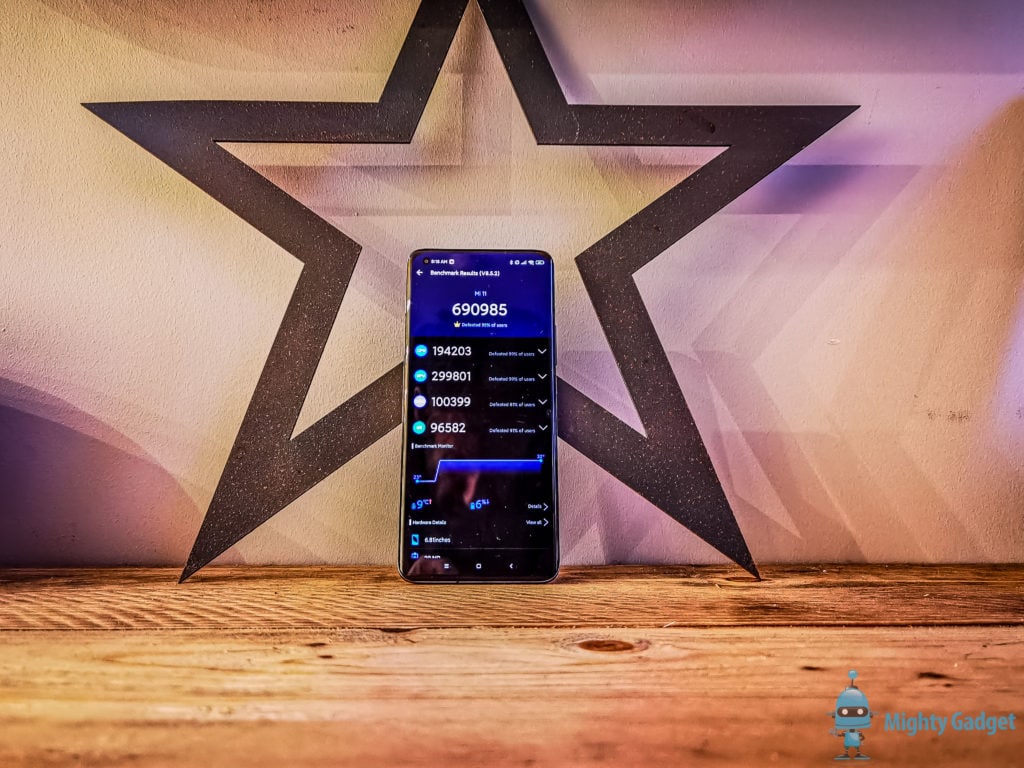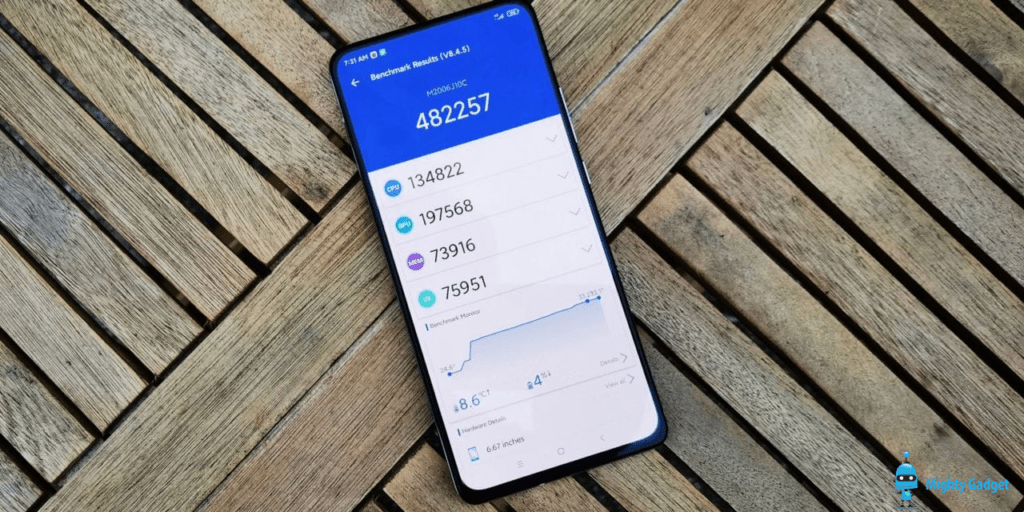Any links to online stores should be assumed to be affiliates. The company or PR agency provides all or most review samples. They have no control over my content, and I provide my honest opinion.
Today, Mediatek took the wraps off its latest two flagship chipsets for 2021. I have already covered how they improved on the Dimensity 1000+, but how do they compare with the Qualcomm and Samsung chipsets you find on the likes of the Galaxy S21 and Xiaomi Mi 11.
MediaTek Dimensity 1200 & 1100 vs Qualcomm Snapdragon 888 & Samsung Exynos 2100 Specifications Table

| Dimensity 1200 | Dimensity 1100 | SD888 | Exynos 2100 | |
| Fabrication Process | TSMC 6nm | TSMC 6nm | Samsung 5nm | Samsung 5nm |
| CPU | 1 x A78 @ 3.0Ghz 3 x A78 @ 2.6Ghz 4 x A55 @ 2Ghz | 4 x A78 @ 2.6Ghz 4 x A55 @ 2Ghz | 1xCortex-X1 @ 2.84 GHz 3x Cortex-A78 @ 2.42 GHz 4xCortex-A55 @ 1.8 GHz | 1x Cortex-X1 @ 2.9GHz 3x Cortex-A78 @ 2.8GHz 4x Cortex A55 @ 2.2GHz |
| GPU | Mali G77 MC9 Manhattan 3.0 @ 130fps peak PUBG Smooth 90fps | Mali G77 MC9 Manhattan 3.0 @ 120fps peak PUBG Smooth 60fps | Qualcomm Adreno 660 +35% perf vs SD865 | Mali G78MP14 @ ? MHz +35% perf vs Exynos 990 |
| Memory | 4x LP4x 2133Mhz PoP UFS 3.1 2 Lane | 4x LP4x 2133Mhz PoP UFS 3.1 2 Lane | 3200MHz LPDDR5 / 51.2GB/s 3MB system level cache | LPDDR5 @ ?MHz ?MB System Cache |
| Camera | 1x 200MP 32MP + 16MP dual | 1x 108MP 32MP + 16MP dual | Triple 14-bit Spectra 580 ISP 1x 200MP or 84MP with ZSL 64+25MP with ZSL 3x 28MP with ZSL 4K video & 64MP burst capture | Single: 200MP Dual: 32MP+32MP (Up to quad simultaneous camera) |
| AI | APU 3.0 +10% perf | APU 3.0 | Hexagon 780 26 TOPS AI | Triple NPU + DSP 26 TOPs |
| Video Decoding | 4K 60fps, 10-bit AV1 | 4K 60fps, 10-bit AV1 | 8K30 / 4K120 10-bit H.265 | 8K60, AV1 Decode |
| Video Encoding | 4K 60fps, 10-bit | 4K 60fps, 10-bit | 8K30 / 4K120 10-bit H.265 | 8K30 & 4K120 |
| Display | QHD+ 90Hz FHD+ 168Hz | QHD+ 90Hz FHD+ 144Hz | No stated | |
| Connectivity | Wi-Fi 6 L1 + L5 GNSS Bluetooth 5.2 | Wi-Fi 6 L1 + L5 GNSS Bluetooth 5.1 | Wi-Fi 6E | Wi-Fi 6E |
| Modem | Sub-6 2CC 5G + 5G DSDS | Sub-6 2CC 5G + 5G DSDS | X60 integrated (5G NR Sub-6 + mmWave) DL = 7500 Mbps UL = 3000 Mbps | Exynos Modem Integrated (5G NR Sub-6) DL = 5100 Mbps UL = 1920Mbps (5G NR mmWave) DL = 7350 Mbps UL = 3670 Mbps |
Comparison
CPU & Fabrication
Mediatek has shifted to the 6nm fabrication process with TSMC, both Qualcomm and Samsung use the same 5nm fabrication process, run by Samsung.
Samsung and Qualcomm have also taken advantage of the new powerful Arm Cortex-X1 core, which is supposed to do away with some power limitations favouring raw power. They then use the Arm Coretex A78 for the middle three cores.
Mediatek have only used A78 cores, there is no explanation why, but there could be exclusivity with the other brands, the licence for the X1 could be too high, or Mediatek deemed it too power inefficient
They have however made up for this on the Dimensity 1200 by clocking the cores very high, which could possibly offer similar performance to the lower clocked Qualcomm chipset.
The Dimensity 1200 is the third chipset, after the SD870, to hit the 3Ghz mark. The single powerful core is clocked at 5.6% above the 2.84Ghz X1 on the Qualcomm, but then the middle cores are also 7.4% higher clocked and the A55 cores 11% higher. So the Dimensity 1200 could, in theory, offer superior multi-core performance
GPU

We see Mediatek take the unusual decision of keeping the GPU specification identical to last years Dimensity 1000+. It is possible frequencies have changes combined with other optimisations, but I wouldn’t be expecting a huge improvement.
So for the MediaTek Dimensity 1200 & 1100, you have a 9-core Arm Mali G77
Then Samsung Exynos 2100 uses the Arm Mali G78 with 14 cores which claim to offer 35% performance improvement vs the Exynos chipset from last year.
The Kirin 9000 deserves a mention here, with its 24 core Arm Mali G78
It is a little hard comparing the GPU of the Qualcomm, which uses their own Adreno 660, but they claim a 35% improvement vs the SD865.
During my testing of the Snapdragon 888, I found that the chipset managed to achieve 37% higher in the GPU score of Antutu vs the previous SD865, and the SD888 achieved 51% higher than the Dimensity 1000+ GPU score.
For 3DMark Sling Shot Extreme OpenGL the SD888 improved on the SD865 by 15% and beat the Dimensity 1000+ by 25%, which, to be fair, isn’t a massive difference (dependant on pricing).

Modem & Connectivity
All the chipsets now off integrated 5G modems, Mediatek were the only company to offer it on a flagship chipset last year.
Qualcomm, and possibly Samsung, both offer Wi-Fi 6E on their chipsets, but the Mediatek is stuck with Wi-Fi 6. This is unlikely to have much of an effect for the next year or so. Wi-Fi 6 is still only just gaining traction, and only one Wi-Fi 6E router is available.
Price & Availability
The Mediatek chipsets have never been about offering the best of the best with specifications; it is more about value for money or the performance you get per $/£.
So judging the MediaTek Dimensity 1200 & 1100 against Qualcomm is a little unfair if the price points are totally different.
We obviously don’t know how much phones with these chipsets will cost, but the Samsung Galaxy S21 starts at £769 and last year it launched even higher than that.
Last year, I bought the Redmi K30 Ultra with the Dimensity 1000+ for $350 imported from China. Even factoring in VAT and import fees that’s hundreds of pounds less than most Qualcomm SD865 phones.
With the recent launch of the Qualcomm Snapdragon 870, it could be that Qualcomm is feeling intimidated by Mediatek’s value approach, so have launched their own lower-cost flagship.
Overall
When comparing the new chipsets against the best Qualcomm and Samsung have to offer, the Mediatek chipsets don’t appear to do so well.
Phone with these Mediatek chipsets are pretty much guaranteed to be more affordable than the Qualcomm counterparts, so it all comes down to performance per £/$. At the moment we have no idea how much these phones will cost, or any phones confirmed to use them. So for the time being the jury is out.
I am, however, very excited at the prospect of MediaTek Dimensity 1200 based phones coming to the UK. I don’t really do anything that pushes the SD888 that much so a more affordable phone would suit me, and likely most people, better.
I am James, a UK-based tech enthusiast and the Editor and Owner of Mighty Gadget, which I’ve proudly run since 2007. Passionate about all things technology, my expertise spans from computers and networking to mobile, wearables, and smart home devices.
As a fitness fanatic who loves running and cycling, I also have a keen interest in fitness-related technology, and I take every opportunity to cover this niche on my blog. My diverse interests allow me to bring a unique perspective to tech blogging, merging lifestyle, fitness, and the latest tech trends.
In my academic pursuits, I earned a BSc in Information Systems Design from UCLAN, before advancing my learning with a Master’s Degree in Computing. This advanced study also included Cisco CCNA accreditation, further demonstrating my commitment to understanding and staying ahead of the technology curve.
I’m proud to share that Vuelio has consistently ranked Mighty Gadget as one of the top technology blogs in the UK. With my dedication to technology and drive to share my insights, I aim to continue providing my readers with engaging and informative content.







